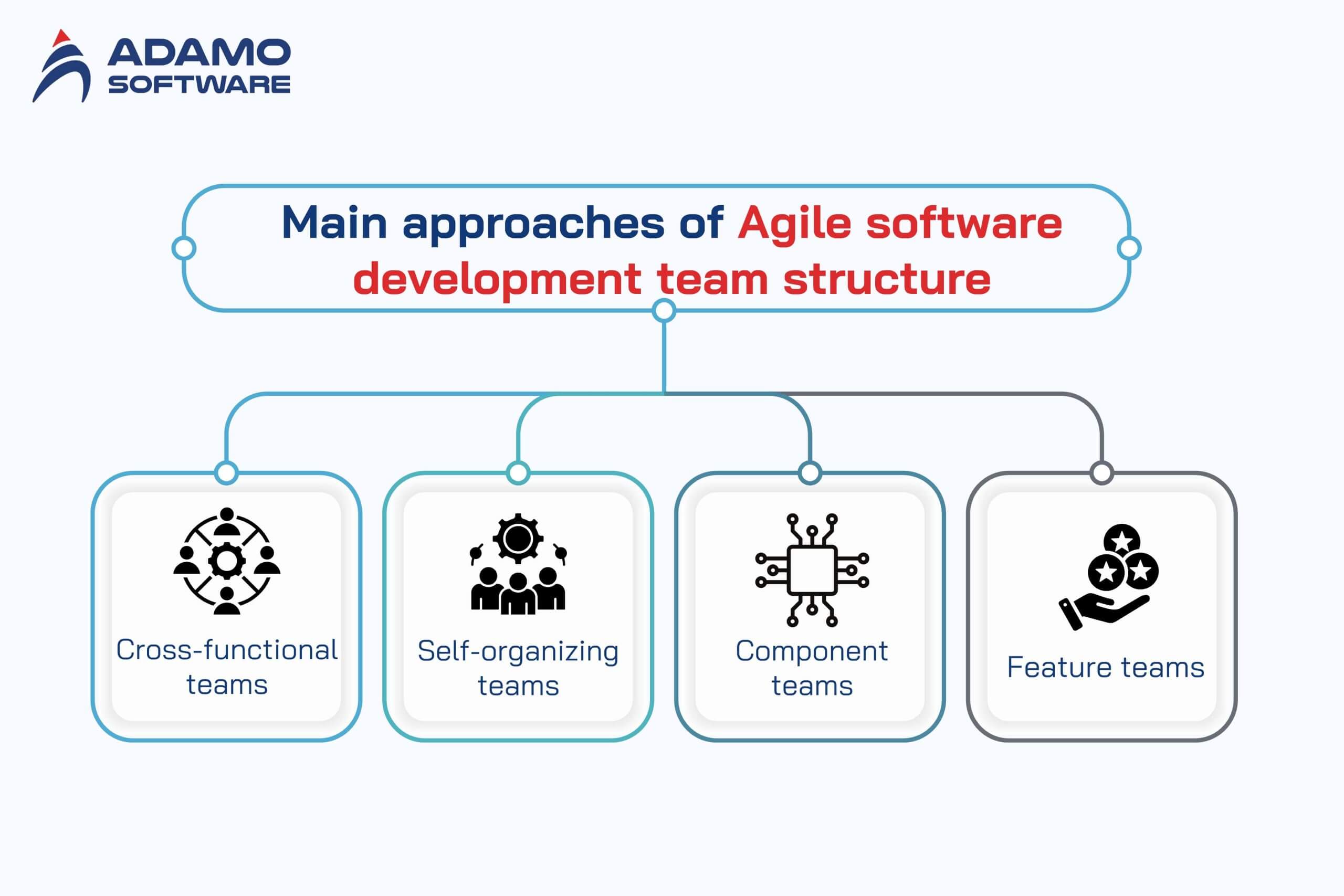Agile software development team structure: A comprehensive guide

Today, the agile software development team structure is becoming increasingly popular among business entities. This structure allows associated teams to be versatile and aligned to change, which is crucial in today’s technologically driven environment. By using the agile approach, people can learn, develop incidentally, and deliver excellent software quickly.
This guide will describe the principles of the agile software development team structure. It helps present the main approaches and the key roles that support them. We will provide the underlying structure of Agile teams. Besides, you will discover the key points, such as when and how to assess its effectiveness. Lastly, we will see how Adamo’s team follows a tight Agile model of project management to attain the project objectives. This guide covers the solid basics of the Agile software development team structure, from the fundamentals of Agile to some improvements.
I. 4 main approaches of agile software development team structure
There are four fundamental approaches to the structure of an agile software development team. The choice of structure enhances quick adaptation and high productivity among the working teams. Below is a detailed description of each approach to see how they support the presence of an agile software development team structure.

1. Cross-Functional Teams
In cross-functional agile SD teams, some members are developers, testers, and designers working together. This diversity of skills allows the team to complete every development phase with the means available within the team. Multifunctional teams help Agile in its objective to improve constantly because individuals can share responsibility for many aspects. Hence, they can solve most problems faster and perform a lot of tasks without wasting so much time.
2. Self-Organizing Teams
Self-organizing agile software development team structure aims to follow the optimality and efficiency of the independent decisions of the team. In this setup, teams can control how they operate, their work schedule, and time tab, which fosters trust and responsibility. Employees can then decide on workload distribution, problem-solving, and cooperation, allowing for more freedom. This approach provides opportunities for unique initiation and fast action, which is aligned with Agile’s objective of fast reaction to alteration.
3. Component Teams
Organizational structures within an adaptive software development team depend on divided component teams. They are matched by technical specialty, for example, a database, backend, or user interface group. It enables subjecting the work to specialized tasks. Therefore, it can generate a high-quality output where there are major projects or complexities. Although component teams may require heavy interaction with other teams, they guarantee that every project component is worked out to the maximum. This approach fits well in a scenario where specific aspects of a given project require special focus and knowledge.
4. Feature Teams
A feature-based agile software development team structure brings all workers for a feature into one team. Team members are involved from the initial stage through to the deployment of the feature. This approach avoids fragmenting the work into scattered tasks. Each team has everything needed to drive a feature to completion. When a feature is developed in isolation, feature teams can integrate, develop, and deliver more effectively. This structure also provides greater flexibility. It aligns well with Agile practices, as iterative work allows each feature to be tested and adjusted in every cycle. These four factors related to agile software development team structure help organizations identify the best team structures for specific objectives. With an appropriate structure, teams become more flexible. They collaborate more effectively. They also work more efficiently to create better software solutions.
II. Defining the types of Agile metrics
The agile metrics are divided into three types: Lean metrics, Kaban metrics, and Scrum metrics.
Lean metrics
Like lean manufacturing, lean metrics focus on optimizing the working process and bring value to the end users. Lead time and Cycle time are two common metrics in this group.
Kaban metrics
Kaban is the borrowed word from Japanese, and it describes the main objectives in workflow, organizing and prioritizing work and completed it, which use a cumulative flow as a common one.
Scrum metrics
Scrum metrics, which is familiar in the Scrum method, which usually use burndown chart and team velocity metrics to measure the delivery of software to customers.
III. Key features of the Agile team organization.
Facilitating critical changes and new, dynamic development team structures are intended to ensure rapid adaptation and fast responses. Agile teams realize value by delivering software in small chunks in an iterative fashion and constantly improving it. Here are the most important principles to identify the key parameters of an efficient structure of an ASDT.

1. Cross-Functional Collaboration
However, cross-functional collaboration is the effort provided by different departments and sections on a particular project and activity. In an agile software Development team structure, individuals are from several skill fields such as development, designing, and testing. Thus, the cross-functional structure enshrined means that all growth phases can be handled within the team structures. Different skill sets ensure that the teams can address issues efficiently and carry out their processes with minimal extra support.
2. Self-Organization
Most of the time, agile teams consist of people who decide how their work should be done. They determine when tasks should be completed and how the work is carried out. Team members can choose what to do, who should do it, and when changes are needed. At this level, self-organization empowers teams to take ownership of their work. They can address issues with immediate responses and solutions. This approach aligns with the principles of a self-directed team (SDT) structure within agile software development.
3. Customer-Focused Mindset
The customer is at the center of an agile software development team structure. Agile’s main thought process reflects the end-users by involving other stakeholders to get feedback in the middle of the work. This means that teams can make improvements where they notice gaps in product delivery. And they can ensure that it meets the customer’s requirements as often as necessary. Customer value is vital in an agile development process as it helps the teams to return better, higher-quality software.
4. Transparency and Open Communication
Transparency is one of the paramount success factors embraced in an agile software development team structure. The members of an agile team do not hesitate to share their status, issues, concerns, and reviews. These interactions are mostly done daily. The scrum meetings are every day, and the retrospectives ensure that anything wrong is corrected quickly. Sharing of information helps in fostering trust with the team members. This makes them receptive throughout the project and offers them a sense of belonging.
5. Continuous improvement commitment
An adaptive software development team structure is committed to more improvement. Scrum teams are always searching for improvement solutions to be more efficient. At the end of the incorporating cycle, the crews join in a retrospective to determine the advantages and the possible improvements. Such commitment to improvement aids in strengthening the teams and making them more efficient each time they perform. For this reason, an agile software development team structure can effectively, promptly, and with the maximum focus on valuable objectives. Through collaboration, self-organization, customer sovereignty, transparency, and reflection, Agile teams are prepared for the development of quality software that is concurrently adapting to change.
IV. Key roles of a typical Agile team
The specific roles in an agile software development team add to the team’s flexibility and efficiency. Job titles can change significantly depending on the project. However, most Agile teams consist of three major roles. Each role helps maintain the structure of the Agile team. These roles also support quick decision-making and continuous improvements. This structure promotes the production of high-quality software.
1. Product Owner
In an agile organization, there is a role called the Product Owner. Customer representatives act on behalf of the customer and work with stakeholders to define key features. The Product Owner is responsible for creating the product’s overall vision. They also manage the product backlog and ensure the team focuses on delivering value. The Product Owner constantly reprioritizes tasks to help the team make sound decisions for its work plan. These decisions are always guided by customer expectations. This position is critical for management to help the team be productive and to deliver the final product when it meets the users’ requirements.
2. Scrum Master
The exact authority of the Scrum Master relates directly to the organization of an agile software development team. There is a coach who ensures that the team implements Agile practices and will address any issues likely to cause interruptions. A Scrum Master orders daily meetings, sprint planning and retrospective sessions. They also promote teamwork and voicing out and solving cases together. Scrum Master is utilizing their efforts in process improvement. This has the effect of keeping the team efficient and able to respond to change.
3. Team Lead
In an agile software development team structure, the Team Lead executes critical functions in controlling and directing the work process. They ensure that the work process does not diverge from Agile practices. An Agile Team Lead does not dictate how tasks should be performed but rather, should encourage the team. They embody ensure the team is fully aware of all the project objectives and that they cultivate a proper working culture. The team leader helps eliminate the barriers that may hinder the team’s performance and create a condition. This ensures the team can effectively deliver value. They provide and ensure effective communication among the team members. They also assist the team can transforming and developing.
4. Development Team Members
Development Team Members are those who effectively contribute to developing the software in an environment of an agile team structure. They encompass developers, designers, and testers having different skills in the team. Members of the development team are responsible for writing code and testing the software. They also handle updates made to the software. The development team cooperates closely with the scrum master and product owner. This ensures that every sprint produces valuable product increments. Team members in this role often work across departments. This cross-functional work allows them to contribute to different areas of the project. Consequently, these key roles contribute towards a balanced functional structure of the agile software development team. The product owner is responsible for prioritizing end customers’ needs. The Scrum Master ensures that Agile flows effectively, and the Development Team facilitates the product. Together, an Agile team can be defined as a set of individuals and their interaction roles. This creates efficiency and responds to change to deliver valuable software solutions regarding producing tangible functionality.
V. When and Why you should choose an Agile software development team structure
Selecting an appropriate software development team structure contributes to the overall performance of a team and its projects. It has been developed as a concept capable of responding to client’s feedback and focusing on it. The following are the reasons or situations may find having an agile software development team structure useful. 
1. When the Project Requires Flexibility
An adaptive model of team structure is appropriate for software development projects when project demands are likely to shift. In Agile, work is organized into short bursts called sprints. This approach makes it easier to adjust plans based on feedback. Such flexibility is beneficial when customer needs or other conditions in the business, market, or operations change frequently. This enables teams to respond to changes fast. As a result, the project remains meaningful and productive.
2. When Speed and Efficiency are Priorities
Agile is designed for rapid development and delivery. By dividing work among teams, tasks can be completed in shorter cycles. This structure enables faster release of small increments. It is particularly beneficial when early versions or updates of an application need to be delivered quickly. Continuous delivery increases efficiency. At the same time, it allows teams to provide value to the market much faster.
3. When Collaboration is Essential
An agile software development team structure is suitable for projects that require extensive coordination and concurrent work organization. Self-organizing work teams meet regularly in daily and weekly scrums. During these meetings, they frequently report to their colleagues and customers. This structure benefits the project by reducing misunderstandings among team members. When people work closely, they are less likely to be suspicious of each other’s intentions. This collaborative environment promotes a positive company culture.
4. When Customer Feedback is Critical
The structure of an agile software development team relies on customer feedback to determine the product’s features. Self-organizing teams collaborate with users and stakeholders to gain insights and make informed decisions. These decisions pertain to products or services that require constant updates. This approach centralizes the development process around the customer. As a result, product development aligns with customer needs and preferences.
5. When Continuous Improvement is a Goal
The foundation of the Agile process is based on continuous improvement. When ongoing enhancements are necessary, the agile approach is the best structure for a software development team. By reflecting on retrospectives, a team can enhance their experience. This improvement, applied to subsequent sprints, leads to a better product. Flexibility, speed, adaptability, customer-centricity, and commitment to regular enhancement are essential. When Agile is implemented, teams can develop high-quality software that meets changing needs and delivers real value in the market.
VI. How to evaluate the performance of an Agile software development team
The viability of an Agile Software Development Team (ASDT) can be assessed by comparing its performance against the organization’s goals and objectives. This evaluation allows various work teams to identify what was done well and where improvements are needed. It also shows how far the teams have progressed. Below are some critical success factors for evaluating an agile software development team structure. Any organization needs to use the following methods when evaluating its agile software development team structure. 
1. Use Key Performance Indicators (KPIs)
It is imperative to establish clear Key Performance Indicators (KPIs). Indexed measures used by an agile Software Development Team (SDT) structure include velocity and cycle time. Velocity measures the amount of work completed in a sprint. Cycle time refers to the time taken to complete a task from start to finish. By using these metrics, teams can more easily assess their efficiency. This process also helps identify trends over time.
2. Conduct Regular Retrospectives
I will point to the fact that retrospectives are best described as a key element of the agile process. In these sessions, the team identifies the strengths, weaknesses, opportunities, and challenges to make changes. This has been made to encourage improvement and innovation and allow team members to speak out. This can help the team’s structure assigned to agile software development fix their strengths and weaknesses. Therefore, the results of future sprints will be even better.
3. Gather Stakeholder Feedback
Various stakeholders can provide valuable feedback when measuring the effectiveness of an agile structure in software development. Daily interactions with customers or stakeholders help ensure that the team’s needs are being met. Surveys, interviews, and feedback sessions can be effective tools for assessing how well the team delivers the right value proposition. This understanding is crucial for facilitating value creation within the project’s trilemma. Additionally, this feedback can inform changes in priorities and processes based on user expectations.
4. Monitor Team Collaboration and Communication
Communication and cooperation as the elements of the organizational structure of an effective team in an agile software development process. The ways in which all team members come across or relate during meetings and how they disseminate information can be quite revealing. Products like tool usage tablets and daily scrums can aid in identifying the level of communication the team has. People should work with each other to solve problems and come up with the right ideas.
5. Define the Quality of Deliverables
The quality of the software developed is another important metric of these firms’ performance. The structure of an agile software development team should therefore aim at result orientation. This can be checked through one or a combination of the following: code review, automated tests, and user acceptance tests. Defect or issue tracking or logging after release can also provide information on the effectiveness of the system and the team’s processes and practices.
6. Assess: Adaptation to change
Agile itself has one of its major values: flexibility, or, in other words, the ability to respond to change. A comparison of how the organized agile software development team structure is suited to changes in requirements or any other (un)complications can be insightful. When teams can switch from one strategy to another, they are generally more productive, and the customers have a happier experience. Applying these methods of assessing the above-discussed agile software development team structure, organizations warrant that these teams are constantly optimized. Evaluations enable the teams to determine which strategies require revision and which should remain as is. This improves the quality of the software and serves the interests of the members and company well.
VII. Adamo’s dedicated development team leverages a comprehensive Agile project management model
The dedicated development team at Adamo is experienced in applying an agile software development team structure. We make processes more effective and create valuable products. This model involves integration, where team members work together in a customer-oriented, flexible, and close-to-meeting needs-as-possible manner. Through Agile approaches, everyone at Adamo interacts closely with each other to function effectively and manage problems.  This means that the development structure at Adamo of an agile software development team for a product facilitates the delivery of the product’s features in cycles. This approach enables a rapid response from stakeholders to determine that the final product suits the customer. Moreover, the dedicated team focuses on continuous improvement, regularly assessing their processes and outcomes to enhance performance. Overall, Adamo’s commitment to an agile software development team structure helps them meet project goals effectively. By fostering a culture of collaboration and adaptability, we deliver innovative solutions that satisfy client expectations and drive business success.
This means that the development structure at Adamo of an agile software development team for a product facilitates the delivery of the product’s features in cycles. This approach enables a rapid response from stakeholders to determine that the final product suits the customer. Moreover, the dedicated team focuses on continuous improvement, regularly assessing their processes and outcomes to enhance performance. Overall, Adamo’s commitment to an agile software development team structure helps them meet project goals effectively. By fostering a culture of collaboration and adaptability, we deliver innovative solutions that satisfy client expectations and drive business success.
FAQs
1. How can Agile teams use metrics to enhance their performance and identify improvement opportunities?
By monitoring and analyzing data related to their project progress, team productivity, and customer satisfaction, Agile teams can use metrics to improve their performance and identify inefficiencies, bottlenecks, and areas for improvement. This allows them to continuously optimize their performance and provide customers with greater value.
2. How do Agile metrics enable stakeholders to monitor progress and make informed resource allocation and project priority decisions?
Agile metrics provide stakeholders with quantitative and objective data regarding the project’s progress and performance. Agile metrics assist stakeholders in monitoring progress, identifying areas for enhancement, and making informed decisions regarding resource allocation and project priorities.
By analyzing these metrics, stakeholders can determine whether or not the project is on course to meet its objectives, identify potential risks or delays, and adjust resource allocation and prioritization accordingly. This ensures that resources are utilized effectively and that project priorities align with the enterprise’s overall goals.
3. What role do Agile metrics serve in fostering an organization’s culture of continuous improvement and innovation?
Agile metrics play a crucial role in nurturing a culture of continuous improvement and innovation within an organization by providing feedback on the performance of the development team and the efficacy of the Agile processes.
Teams can use metrics to improve their work quality and speed by monitoring cycle time, lead time, throughput, work in progress, work item age, flow efficiency, and blocked time.
This encourages a culture of experimentation and empowers teams to innovate and deliver consumer value more effectively and efficiently. Teams can also foster transparency, collaboration, and a shared commitment to continuous improvement by sharing and discussing metrics openly with stakeholders.











